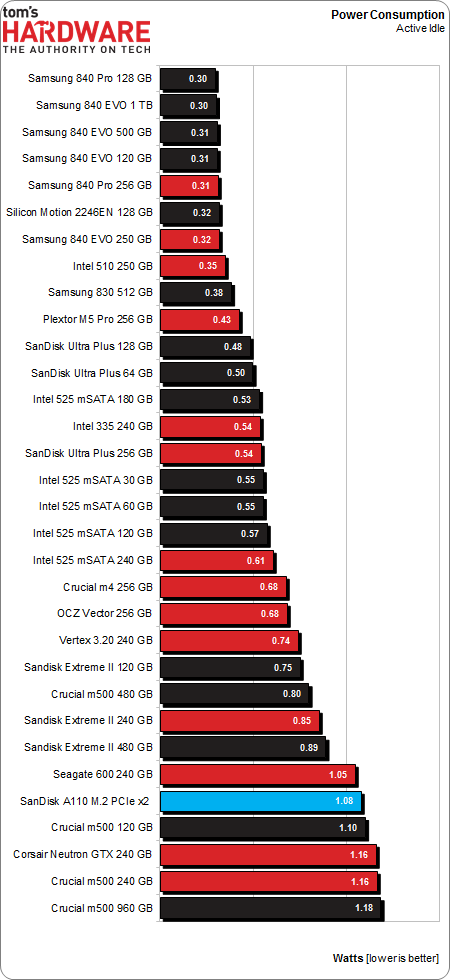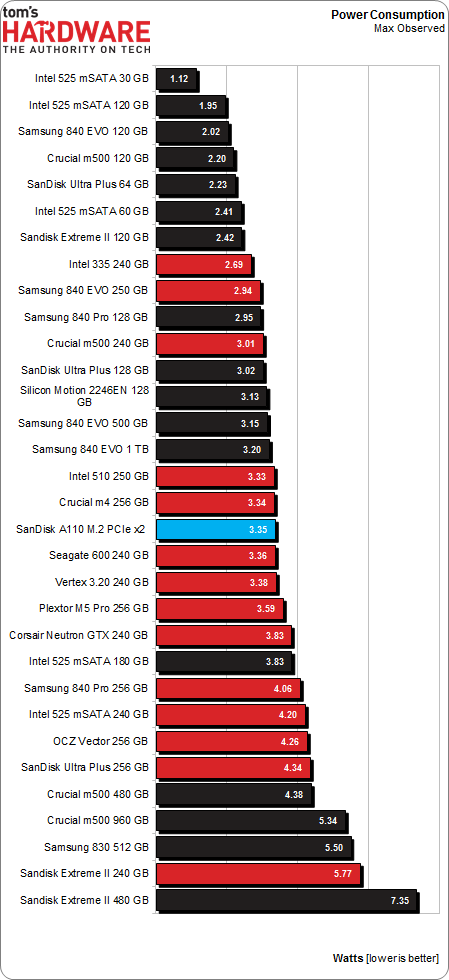SanDisk A110 PCIe SSD: Armed With The New M.2 Edge Connector
We got our hands on an early sample of SanDisk's A110 SSD. So what? Big deal? Not a chance. This thing is PCI Express-attached and sports the new M.2 edge connector. Read on to learn more about the next generation of solid-state storage connectivity.
Results: Power Consumption
Idle Power Consumption
Idle consumption is the most important power metric for consumer and client SSDs. After all, solid-state drives complete host commands quickly, and then drop back down to idle. Aside from the occasional background garbage collection, a modern SSD spends most of its life doing very little. Enterprise-oriented drives are more frequently used at full tilt, making their idle power numbers far less relevant. But this just isn't the case on the desktop, where the demands of client and consumer computing leave most SSDs sitting on their hands for long stretches of time.
Active idle power numbers are critical, especially when it comes to their impact on mobile platforms. Idle means different things on different systems, though. Pretty much every drive we're testing is capable of one or more low-power states, up to and including DevSleep. DevSleep is a part of the SATA 3.2 host specification, and while it requires a capable SSD and a compatible platform, enabling it takes storage down to very little power use. This is why we test active idle; it's easy to identify and is still where SSDs spend most of their time.
The A110 poses special issues where power consumption testing is concerned, since its PCIe nature makes it difficult to measure. Fortunately, the x4 PCIe-to-M.2 PCIe adapter we have lets us power the drive using external power, via four-pin Molex connector. That makes taking a reading easier, though we're not certain yet whether the accuracy is affected.
PCMark 7 Average Power Consumption
If we log power consumption through a workload, even a relatively heavy one, we see that average use is still pretty close to the idle numbers. Max power may spike fiercely, but the usage seen during a PCMark 7 run is pretty light. You can see the drives fall back down to the idle "floor" between peaks of varying intensity.
The A110 spends most of its time at the idle power state we measured, but increases from there. The spikes are super-short though, telling us that SanDisk's drive does what it's asked and then drops back to idle quickly. PCMark 7 doesn't tax the A110 much at all.
In fact, the A110 uses just slightly more power, on average, in this workload than it did in our idle measurement. As a result, it moves up this chart.
Get Tom's Hardware's best news and in-depth reviews, straight to your inbox.
Maximum Observed Power Consumption
It's even better news that maximum power consumption isn't a critical specification for most desktop workloads. In the enterprise space, yes. This information goes into the calculation for total cost of ownership. But in a client environment, you shouldn't be seeing these numbers for more than short bursts.
No matter what tortuous workload we threw at it, the 256 GB A110 wouldn't use more than 3.5 W. SanDisk rates the drive for up to 5.5 W in write tasks, but we were unable to approach that figure.
Current page: Results: Power Consumption
Prev Page Results: File Copy Performance Next Page PCI Express-Attached M.2: Ready For Prime Time-
Mike Friesen Awesome new stuff. Can't wait to see if this drive actually uses the full potential of the M2, and if Samsung or OCZ can one-up them.Reply -
cryan Reply11487924 said:Awesome new stuff. Can't wait to see if this drive actually uses the full potential of the M2, and if Samsung or OCZ can one-up them.
Samsung actually has some pretty awesome M.2 PCIe action going on. We're trying to get our hands on everything, so stay tuned.
Regards,
Christopher Ryan
-
It will be nice to see vendors implement the NVMe connectors in the desktop mobo's, which in turn will redefine case design, as less storage space will be required for storage. I am aware that the initial intent is to direct these at the mobile market, but desktops can benefit as well.Reply
-
cryan Reply11488018 said:It will be nice to see vendors implement the NVMe connectors in the desktop mobo's, which in turn will redefine case design, as less storage space will be required for storage. I am aware that the initial intent is to direct these at the mobile market, but desktops can benefit as well.
You'll really see NVMe take off on the desktop with the move towards SATA Express. A SSD on SATA Express will leverage NVMe and two PCIe Gen 3 lanes. Though some motherboards will (and already do) have M.2 connectors, M.2 really makes more sense in mobile applications. M.2 will only get traction on the desktop insofar as it will begin to replace mSATA. Tons of mainboards, especially smaller form factor products embrace mSATA, and moving to M.2 is a natural transition. However, M.2 drives are hard to find right now, and we really won't see a plethora of options until next year.
Regards,
Christopher Ryan
-
nekromobo I got M.2 toshiba ssd in my Sony Vaio Pro 13.. review that?Reply
and it should have samsung M.2 in some countries.. -
CaedenV I may no longer have motivation to upgrade my system based on CPU specs, but with DDR4, M.2, new restive storage based SSDs, and better chipset features I will still have enough reason to upgrade in a year or two.Reply -
jimmysmitty Reply11488122 said:11488018 said:It will be nice to see vendors implement the NVMe connectors in the desktop mobo's, which in turn will redefine case design, as less storage space will be required for storage. I am aware that the initial intent is to direct these at the mobile market, but desktops can benefit as well.
You'll really see NVMe take off on the desktop with the move towards SATA Express. A SSD on SATA Express will leverage NVMe and two PCIe Gen 3 lanes. Though some motherboards will (and already do) have M.2 connectors, M.2 really makes more sense in mobile applications. M.2 will only get traction on the desktop insofar as it will begin to replace mSATA. Tons of mainboards, especially smaller form factor products embrace mSATA, and moving to M.2 is a natural transition. However, M.2 drives are hard to find right now, and we really won't see a plethora of options until next year.
Regards,
Christopher Ryan
That's what I was thinking. SATA Express is going to be fast enough for now as I have used PCIe SSDs before (OCZ Revo based drive) and compared to my 520 its hard to notice a difference, especially since there are other bottlenecks stopping it from being able to utilize that bandwidth.
This will be great for ultra portable systems though and ITX systems.
-
cryan Reply11488367 said:I got M.2 toshiba ssd in my Sony Vaio Pro 13.. review that?
and it should have samsung M.2 in some countries..
Absolutely... just send it my way and consider it done.
Regards,
Christopher Ryan
-
mikeangs2004 will there be RAID or SLI/CFX for PCIe based SSD's?Reply
I don't think so b/c it's already way above 6G limit.



